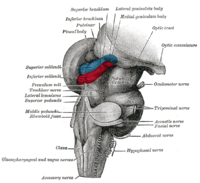
Photo from wikipedia
Traditionally, the dorsal lateral geniculate nucleus (LGN) and the inferior pulvinar (IPul) nucleus are considered as anatomically and functionally distinct thalamic nuclei. However, in several primate species it has also… Click to show full abstract
Traditionally, the dorsal lateral geniculate nucleus (LGN) and the inferior pulvinar (IPul) nucleus are considered as anatomically and functionally distinct thalamic nuclei. However, in several primate species it has also been established that the koniocellular (K) layers of LGN and parts of the IPul have a shared pattern of immunoreactivity for the calcium‐binding protein calbindin. These calbindin‐rich cells constitute a thalamic matrix system which is implicated in thalamocortical synchronisation. Further, the K layers and IPul are both involved in visual processing and have similar connections with retina and superior colliculus. Here, we confirmed the continuity between calbindin‐rich cells in LGN K layers and the central lateral division of IPul (IPulCL) in marmoset monkeys. By employing a high‐throughput neuronal tracing method, we found that both the K layers and IPulCL form comparable patterns of connections with striate and extrastriate cortices; these connections are largely different to those of the parvocellular and magnocellular laminae of LGN. Retrograde tracer‐labelled cells and anterograde tracer‐labelled axon terminals merged seamlessly from IPulCL into LGN K layers. These results support continuity between LGN K layers and IPulCL, providing an anatomical basis for functional congruity of this region of the dorsal thalamic matrix and calling into question the traditional segregation between LGN and the inferior pulvinar nucleus.
Journal Title: European Journal of Neuroscience
Year Published: 2019
Link to full text (if available)
Share on Social Media: Sign Up to like & get
recommendations!